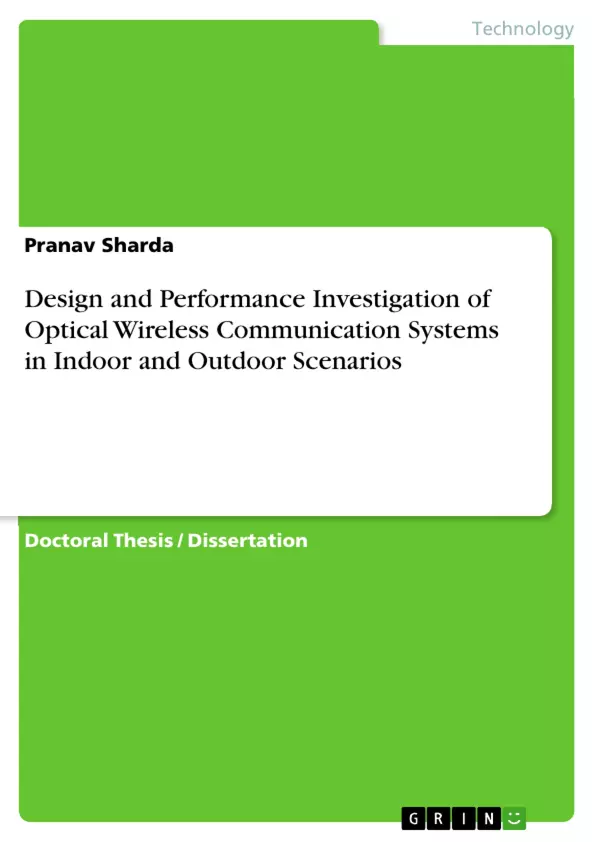Over the recent few years, optical wireless communication (OWC) has attracted significant attention in both academia and the research community. Contrary to radio frequency (RF) systems, the spatial confinement of the optical beams makes the OWC system a potential system offering higher data rates and secured communication. OWC systems and applications in several areas, such as terrestrial outdoor (free-space optical (FSO) communication), indoor and outdoor visible light communication (VLC), etc. For the terrestrial outdoor FSO systems, spatial diversity techniques are employed over FSO links to enhance the diversity and overall performance. To this end, the spatial diversity techniques corresponding to the state-of-the-art are repetition coding (RC), transmit laser selection (TLS), and orthogonal space-time block codes. Note that, TLS is the optimal transmission scheme in the FSO systems. In this dissertation, we name the conventional TLS scheme as a single TLS (STLS) scheme. However, the performance of the conventional STLS scheme is highly dependent on the feedback errors. On the other side, the outdoor VLC finds applications in vehicle-to-vehicle (V2V) communications, infrastructure-to-vehicle (I2V) communications, etc. Emphasizing the state-of-the-art corresponding to the outdoor V2V-VLC systems, there is a lack of comprehensive modeling and performance investigation under the adverse challenges of the outdoor VLC environment. Moreover, to address the challenges of the next-generation-based outdoor intelligent transportation systems (ITSs), an indoor testbed design for an outdoor I2V-VLC system is still missing.
In order to enhance the diversity and overall performance of the terrestrial outdoor FSO systems, the study begins by proposing two novel TLS schemes. We call the proposed schemes as two TLS (TTLS) and modified error-tolerant weighting scheme (METWS). Note that, the conventional STLS scheme gives optimal performance under a perfect feedback scenario. However, its performance degrades significantly under an imperfect feedback scenario. To this end, the two proposed schemes overcome the practical limitations of the conventional STLS scheme. Moreover, we analyze the performance of the two proposed schemes for both perfect and imperfect channel state information (CSI)-based communication scenarios. Further, different performance metrics, such as bit error rate (BER), diversity gain, etc., are thoroughly analyzed. Furthermore, to gain more insight
Inhaltsverzeichnis (Table of Contents)
- Introduction
- Motivation and Objectives
- Overview of the Research Area
- Contributions of the Thesis
- Background
- Optical Wireless Communications
- Overview of OWC Technology
- Advantages and Disadvantages of OWC
- OWC Applications
- OWC Channel Models
- Free-Space Optical Communication
- Atmospheric Turbulence
- Point-to-Point FSO Links
- FSO Channel Models
- Image Transmission over FSO Links
- Overview of Image Transmission Technologies
- Image Quality Metrics
- Challenges of Image Transmission over FSO
- System Model and Design
- System Architecture
- Transmitter Design
- Receiver Design
- Channel Model
- Atmospheric Turbulence Model
- Pointing Error Model
- Performance Metrics
- Bit Error Rate (BER)
- Peak Signal-to-Noise Ratio (PSNR)
- Average Optical Power Received by the Receiver
- Simulation and Results
- Simulation Setup
- Performance Evaluation of Different OWC Scenarios
- Non-Line-of-Sight (NLOS) OWC Scenarios
- Line-of-Sight (LOS) OWC Scenarios
- Comparison of Different System Architectures
- Comparison of Different Receiver Designs
- Comparison of Different Modulation Schemes
- Impact of System Parameters on Performance
- Impact of Atmospheric Turbulence on Performance
- Impact of Pointing Error on Performance
- Impact of Receiver Field of View (FOV) on Performance
- Conclusions and Future Work
Zielsetzung und Themenschwerpunkte (Objectives and Key Themes)
This thesis explores the feasibility of image transmission over free-space optical (FSO) links in various challenging scenarios, such as non-line-of-sight (NLOS) and urban environments. The main objective is to develop a comprehensive system model and evaluate the performance of different FSO system architectures and modulation schemes in these challenging scenarios. Key themes addressed in the text include:- Impact of atmospheric turbulence on FSO link performance
- Performance analysis of different OWC system architectures, including receiver designs and modulation schemes
- Impact of NLOS conditions and urban environments on FSO link performance
- Development of optimized system parameters for reliable and efficient image transmission
- Evaluation of various system performance metrics, including bit error rate (BER) and peak signal-to-noise ratio (PSNR)
Zusammenfassung der Kapitel (Chapter Summaries)
- Chapter 1: The introductory chapter provides motivation, background information, and an overview of the research area. It outlines the objectives, contributions, and organization of the thesis.
- Chapter 2: This chapter delves into the relevant background information, including an overview of optical wireless communications, free-space optical communication, and image transmission technologies. It also explores the challenges associated with image transmission over FSO links.
- Chapter 3: This chapter presents the detailed system model and design of the FSO link, including the transmitter, receiver, and channel models. It also outlines the performance metrics used to evaluate the system.
- Chapter 4: This chapter focuses on the simulation and results, presenting the performance evaluation of different OWC scenarios, comparing different system architectures, and analyzing the impact of system parameters on performance.
Schlüsselwörter (Keywords)
The primary keywords and focus topics of this thesis include optical wireless communications, free-space optical communication, image transmission, atmospheric turbulence, non-line-of-sight (NLOS) communication, urban environments, system architecture, modulation schemes, bit error rate (BER), peak signal-to-noise ratio (PSNR), performance evaluation, and simulation. The work explores various aspects of OWC systems, including channel modeling, receiver design, and system performance analysis.- Arbeit zitieren
- Pranav Sharda (Autor:in), 2023, Design and Performance Investigation of Optical Wireless Communication Systems in Indoor and Outdoor Scenarios, München, GRIN Verlag, https://www.grin.com/document/1477216



